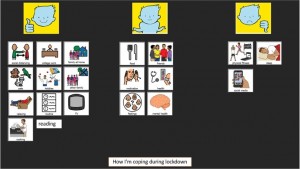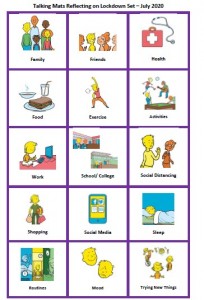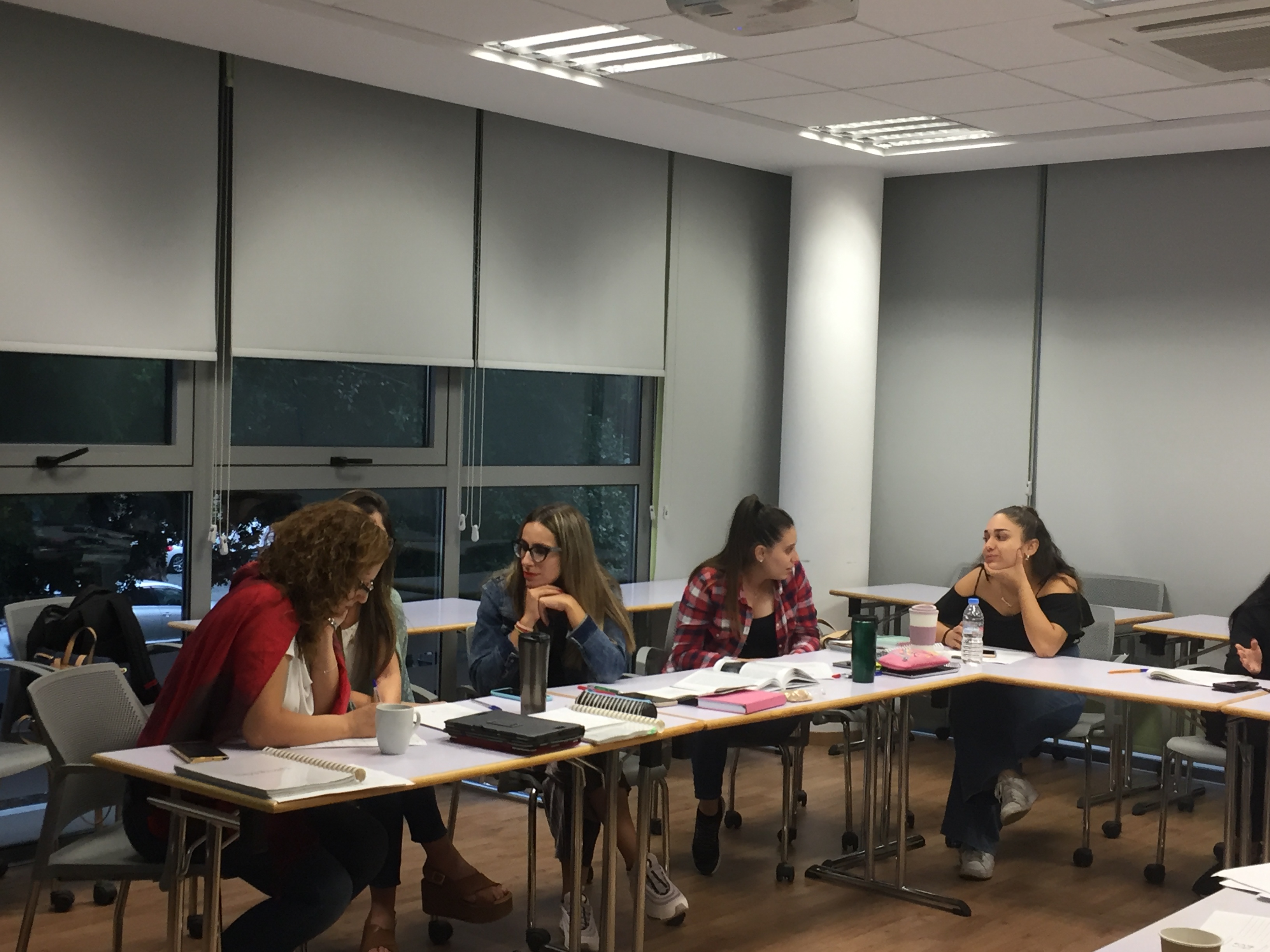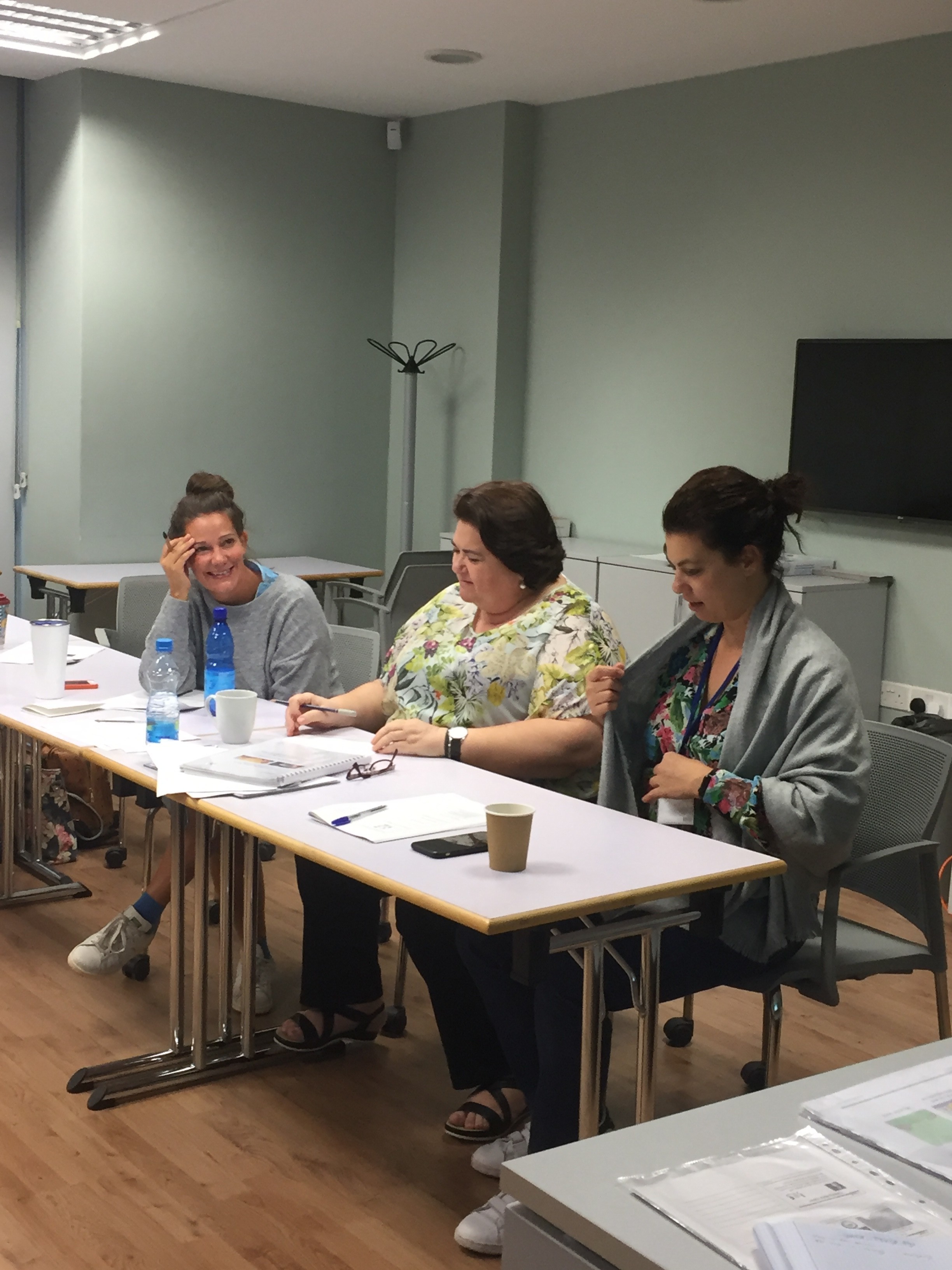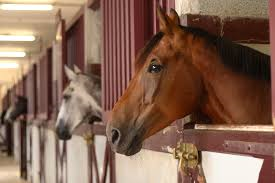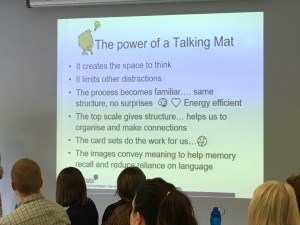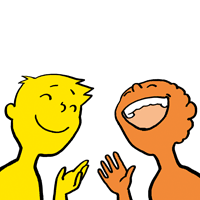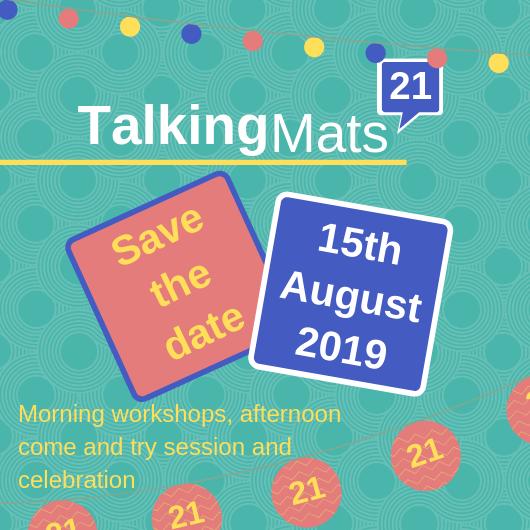The previous blog (read here) described the development of a set of symbols to prompt discussions around identity. In this blog, the authors illustrate how the symbols can be used to support practitioners to consider their own ideas about identity and how this may influence the clinical relationship.
The completed resource was trialled with practitioners working in a variety of settings.
Feedback
‘It help me understand and reflect on my own biases and how I am slowly working to be more aware of them and ask the right questions’
‘This Talking Mat was an eye opener about my worries and anxieties around saying the wrong thing’
Overall practitioners reported that using the resource helped;
• understanding and reflection on own biases and challenge default assumptions
• consideration of wider aspects of identity that were not routinely thought about
• holistic thinking by encouraging seeing clients in a wider context
• stimulate ideas about different questions to ask
• provide a safe platform for staff to open up
• address your own anxieties as a professional about getting it wrong and fear of ”putting your foot in it”.
It was also agreed that the resource could be used in diverse settings and not only within AAC.
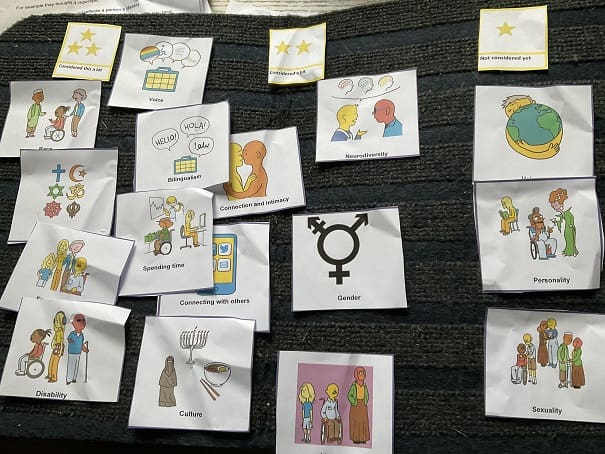
Next steps
At the start of the process we were not sure where the discussions with the original project group would lead but the results of the pilot have shown that this Talking Mats identity resource is helpful for practitioners to mindfully reflect on their practice, allow unconscious bias to rise to the surface, consider all aspects of their clients’ identity to develop their practice, contribute to reducing inequalities and improving the responsiveness of services.
If you would like to know more about this resource and how it can support practitioners, please join Lois, Nikki and Lucia for an online webinar on
Tuesday 13th August 2pm – 3.30pm
This week’s guest blog, the first of 2 from the authors (Lois Cameron, Nikky Steiner and Luccia Tullio), describes the development process of a set of symbols aimed at supporting practitioners to reflect on the role of identity within their practice.
Every person has their own unique identity, just like they have their own unique fingerprint.
Identity is about how we see ourselves and how the world sees us.
Background
The Royal College of Speech and Language conference 2021 was titled ‘breaking barriers and building better.’ Professor Harsha Kathard from the University of Cape Town gave the keynote presentation and reflected on the key role understanding identity has in clinical practise, stating that ‘understanding identity is key to inclusion’. Secondly, she stressed that if we want to develop better services and support then ‘Turning the gaze to reflect on our positionality is central to change’ .Ash R et al (2023) in their editorial for the British Medical Journal highlight how interventions normally focus on single categories of social identity and ‘fail to account for the combinations of, or intersections between, the multiple social characteristic that define an individual’s place in society.’ They argue that ‘systems of care may consequently overlook overlapping systems of discrimination and disadvantage and exacerbate and conceal health inequities.’
The Development group
Following feedback from clinicians and people who use Alternative and Augmentative Communication (AAC) a working group was formed in March 2021 to explore the role of identity, diversity, equality and inclusion with in AAC practice.
Communication Matters and AAC networks within the UK advertised the group and 12 people responded. These people came from a range of organisations and had a range of lived experiences of diversity including people who use a communication aid to help them communicate. The work was funded by the Central London Community Health Trust and Talking Mats Ltd facilitated the meetings and the work
The group worked shaped the resource by reaching a consensus about the components of life that contributed to identity. In the end the group agreed on gender, sexuality, disability, race, neurodiversity, culture, family structure, voice, bilingualism, religion, mental health, personality, politics, intimacy, connecting with others and occupation. The process of developing the symbols was hugely helpful in unpicking what was actually meant by the various aspects e.g. voice. The original image for voice represented accents but the group discussion shaped the image to represent much more so the final image included a rainbow flag, a more general sound wave to represent tone, a Spanish word and an image to represent disability. As one group member said ‘my cerebral palsy is part of my identity. If I am having a voice I want to reflect that identity – I want a cerebral palsy voice’. Identity and the issues surrounding it can be emotive but the focus on the symbols helped contain the emotion and supported group members to listen to the perspective of others.
The whole iterative process of developing the resource and clarifying what the symbols should look like allowed the group to be clear about the individual meanings of abstract topics. This wider understanding was captured in a glossary to go alongside the symbols. For example, Identity has the following definition: Every person has their own unique identity, just like they have their own unique fingerprint. Lots of different characteristics make up our identity. This is what makes us different from other people. Sometimes we may share some of these characteristics with other groups of people, which can also be part of our identity. Identity is about how we see ourselves and how the world sees us.
Equality, Diversity and Inclusion: a visual framework to support the exploration of Identity within practice.
The resource is seen as a support for constructive reflection by practitioners on identity and allows them to consider the different aspects of their patients’ lives that may impact on their interventions. The final Talking Mats symbols have the suggested top scale of ‘I considered a lot’, ‘I considered a bit’, ‘I have not considered yet ‘. It could be used individually or by a team as a group discussion tool.
As the resource uses the Talking Mats framework, it is recommended that practitioners have completed their Talking Mats foundation level training
If you are interested in completing Talking Mats Foundation Training, you can see the training options in our shop here.
References
Kashard H 2021 Keynote breaking barriers and building better The Royal College of Speech and Language conference.
Ash Routen, 1 Helen-Maria Lekas, 2 Julian Harrison, 3 Kamlesh Khunti1,2023 Interesectionality in health equity research BMJ 2003 https://www.bmj.com/content/383/bmj.p2953
Our thanks for this blog go to Deborah Little, Speech and Language Therapist; Clinical Lead for AAC & Total Communication (Children and Young People) NHS Dumfries and Galloway.
“Can we do a Talking Mat today Deborah? This is the question I am asked as soon as I enter the Learning Centre in one of our local schools by an enthusiastic 8 year old who has been exploring what completing a Talking Mat (TM) is all about this term. While we are in the early stage of this school’s TMs journey, the impact of embedding the approach into the fabric of how Children and Young People (CYP) are supported to communicate in school is already proving transformative.
Article 12 of The United Nations Convention on the Rights of the Child (UNCRC) guarantees children the right to express their views and opinions freely in all matters affecting them. The responsibility of ensuring children experience this right is also underlined in NICE guidelines (2022) that state: “Education, health and social care practitioners should always: put the life goals and ambitions and preferences of the disabled child or young person with severe complex needs at the centre of planning and decision making.”
Working with my teaching colleagues within one Additional Support Needs (ASN) setting this year, we reflected on how effectively the CYP were able to give their views and how consistently these views were acted upon in meaningful ways. We felt that this was an area we really wanted to improve upon and specifically we wanted to explore the following key questions in our minds:
- How can we support CYP’s understanding of their right to give their views and opinions? We reflected that for some CYP, their experience of being able to do this was very limited and that their understanding of using a TM was not yet at a stage where they were able to represent their views. We therefore wanted to prioritise finding out what helped these CYP to use TMs with understanding.
- How can we support CYP to know that they can tell us they aren’t happy about something? We reflected that during ‘Emotions Works’ discussion times many of the CYP routinely shared that they felt ‘happy.’ It was rare for the CYP to talk about unhappy feelings. We felt worried that the CYP often gave responses that they felt would be ‘right’ or pleasing to adults.
- How can we ensure we create a culture of prioritising time and space for CYP to share their views, opinions and ideas? We thought about opportunities throughout the school week that would create space and motivation for the CYP to engage with TMs. We wanted to achieve a feeling of TMs being integral to the everyday, as opposed to a sporadic ‘add on.’
To answer these questions, we agreed on the following key change ideas to implement and evaluate:
Developing understanding of the Talking Mats process linked with familiar learning opportunities.

Dynamic Assessment is an approach familiar to those working with CYP who use Augmentative and Alternative Communication (AAC). Adapting activities dynamically, being responsive to CYP’s progress, allows progressive skill enablement. Together with teaching colleagues, we applied this thinking to helping the children use TMs with understanding. If we had tried having a conversation using TM only a couple of times, our evaluation could have been that TMs wasn’t yet a tool we could use because for example, the CYP were putting all their symbols into the ‘I’m happy with this’ column only. Instead, we thought “OK, that’s where the CYP are now, let’s give them opportunities to practise engaging with this new tool and time to develop using the approach with understanding.” Put another way, we prioritised another key concept within the field of AAC: we Presumed Competence. We believed that the CYP had the ability to share their thoughts, feelings and ideas if we introduced TMs gradually, linking with the activities above, that were tangible and familiar to the thinkers.
Consciously modelling that is OK to have negative feelings and opinions.
When a CYP is learning what might be possible in terms of communicating with AAC, best practise is for supporting adults to model the AAC. This means, adults ‘use AAC to teach AAC.’ We show CYP that we highly value the AAC and want to use it too. We use it in real situations, modelling vocabulary to help CYP understand the symbolic vocabulary and how they can begin to use it too. When helping the CYP understand how TMs could help them express a wider range of emotions, we tried out using this approach. Now and again, supporting adults would share with the CYP how they were feeling about things using TMs and would include negative feelings.

One CYP had a memorable response to my sharing that I was feeling “not happy” with my cat. The CYP’s eyes widened and he became instantly animated, using his AAC to ask “cat..bad..what?” I was able to explain that my cat had been scratching my carpets and I was feeling upset about this. The CYP then used his AAC to say “cat…dig!” He pointed at the ‘not happy’ symbol in the Talking Mats top scale, jointly sharing his attention to this symbol and understanding of what this meant with me. The next week, we used TMs to ask this young person about a social group he had attended. For the first time, we noticed him ‘swithering’ across his top scale while making his choices. Also for the first time, I was confident that he shared his authentic feelings with me. I reflected on the power of modelling and normalising feelings that are ‘not happy.’
So, where are we now? The key themes from our findings after a year of using TMs as described above are:

In summary, using TMs in this setting has all supporting practitioners in agreement that it is not only important to listen to CYP when we know they might be having a tough time; we need to create space to listen all of the time, week to week, with authenticity and without agenda. The principles regularly used within AAC practice of: modelling, presuming competence and dynamic assessment have been effective in supporting more children to be able to experience their UNCRC Article 12 Right, more of the time and with increased understanding and confidence.
References
- UN Convention on the Rights of the Child – UNICEF UK
- NICE Guidelines [NG213] (2022) Disabled Children and Young People up to age 25 with severe complex needs: integrated service delivery and organisation across health, social care and education.
- Emotion Works www.emotionsworks.org.uk
- Daneshfar, S and Moharami, M (2018) Dynamic Assessment in Vygotsky’s Socioculturaly Theory: Origins and Main Concepts. Journal of Language Teaching and Research 9(3):600
- Donnellan, A (1984) The Criterion of the Least Dangerous Assumption. Behavioural Disorders, 9 (2), 141-150
- Sennott, Light and McNaughton (2016) AAC Modelling Intervention Research Review. Research and Practice for Persons with Severe Disabilties 41 (2)
On Wednesday November 10th we held a colloquium with the University of Edinburgh and NHS fife to report on the findings of the research that was funded with the Burdett foundation . The easy-read version of this report can be found here.
48 people attended the online event on Wednesday and engaged in some very thoughtful discussion and reflection on communication in forensic settings. There was much to think about including whether ethos and values align with self-determination , how to get communication taken seriously by staff who are often under huge pressure. Consideration of where power lies in an organisation and an acknowledgment that in order to share power staff themselves need to feel they have power.
The recognition that in the promotion of shared decision making, you increase the risk of people taking what others may see as unwise decisions. The need to support the capacity of people to be involved in decision making early on and in the smaller decisions of life and not leaving including them to a crisis.
The importance of further research in his area and that small clinically driven research projects have an important role to play in addition to ones funded by bigger grants. There is much to digest and we are hoping to keep the conversation going.
If you would like to see for yourself the research presented and the topics discussed at the colloquium you can watch the recording of the Zoom session here.
If you want to attend foundation Talking Mats training please find out more here. if you have completed your foundation training please consider attending the Keeping Safe advanced online module which includes the Keeping Safe resource . If you have the Keeping Safe resource please download the new Being Included bolt on to use with it.
During May we are hosting 3 one hour webinars which will demonstrate the new digital Talking Mats that is currently being developed for us by our technical partners MTC.
The webinar will focus on demonstrating its new features including:
- technical specification for use
- the range of symbols sets availableincluding Keeping Safe, Thinking Ahead, Health and Housing and the Leisure subsets of Sports and Out and About
- how to add your own photos
- how to make sub mats ,
- how to useit to support effective remote conversations
- how to file restore and retrieve individual mats.
The migration from our current system to this will be explained as well as how to purchase and use if you are a new user.
Please note this is not a Talking Mats training.
Choose a webinar that suits your time zone and work pattern and book a place. All times are GMT
- SOLD OUTTuesday 11th May 9.30 -10.30 am SOLD OUT
- Monday 17th00-5.00 pm
- Thursday 27thMay 1-2.00 pm
All webinars are free and we would love to see you to show you he new digital Talking Mats
I stole the lyrics and altered them slightly, but this is the song line that has kept popping into my head over the past few weeks as we find ourselves hurtling through the different phases of lockdown easing. The rules and recommendations that have guided our lives for the past 3 months or so are changing rapidly and change can be difficult. Communicating how we feel about change and life in general can be difficult.
We have seen creative uses of our resources and have really enjoyed learning how they have helped young people and adults express how they coped throughout lockdown and beyond. Kirsten Lamb’s guest blog about Returning to School After Lockdown is just one example of how the TM framework was invaluable in gaining the opinions of young people as they adapted to ongoing changes over which they had little or no control.
https://www.talkingmats.com/returning-to-school-after-lockdown/
Another Talking Mats practitioner recently tweeted this mat that she did with a college student, showing how Talking Mats helped structure thinking about how life was going.
We felt a single resource was needed to help kick start a conversation around Life (but not as we know it; I am sure that’s a song too) looking at the following themes:
- Family / Friends / Bubbles / Social Distancing
- Health
- Mood / Emotion
- Sleep
- Exercise
- Work
- School / College
- Activities
- Shopping
- Routine
As with every Talking Mat you can change the top scale to be more or less concrete, you can use blanks to add in things that we haven’t included, you can leave things out that aren’t relevant. Download your free printable pdf here: LOCKDOWN SET
We look forward to hearing stories from our Talking Mats Community on how you helped others express themselves (definitely another song!)
Many thanks to our Talking Mats Founder, Dr Joan Murphy, for this latest blog talking about the training course she recently delivered at the Cyprus University of Technology.
Cyprus is a beautiful Mediterranean island with a population of approximately 1 million.
I was invited by Dr Eliada Pampoulou to run a 2-day course on Talking Mats for 12 Speech and Language Therapists, some of whom are masters students and some, lecturing staff at the Cyprus University of Technology. The Cyprus University of Technology founded the first Department of Rehabilitation Sciences in Cyprus and the Department offers the first public recognised university bachelor degree in Speech Language Therapy / Speech Language Pathology in the Greek language (https://www.cut.ac.cy/faculties/hsc/reh/).
Day 1 was a Talking Mats foundation training course and Day 2 focused on discussion around capacity, research and clinical applications. This model worked very well as the participants were able to think about and discuss how to apply the training immediately.
Some of the immediate plans of the participants were both clinical and research oriented and are outlined below:
- To administer the Greek Stroke and Aphasia Quality of Life Scale (SAQOL-39) with healthy people over 50 both with the text version and an adapted Talking Mats version quality and to examine which they prefer.
- To use Talking Mats both with people with people with aphasia and their carers in order to share their understanding about the communication skills and needs of people with aphasia.
- To use Talking Mats as a tool to identify the factors that are related to AAC system acceptance or abandonment by focusing directly to the views of people with complex communication needs
- To use Talking Mats as a goal setting tool for both paediatric and adult population
- To use Talking Mats to gets clients feedback about therapy services
- To use Talking Mats for student appraisals regarding their clinical training
Dr Eliada Pampoulou has created the first Talking Mats centre in Cyprus which aims to gather all people who received training every few months to share their experiences and support each other to embed Talking Mats in practice and research.
We hope that Eliada will come to Stirling next year to gain her Talking Mats licence to enable her to train others and extend the reach of Talking Mats even further.
We regularly run our Licensed Trainer 2-day courses at our base in Stirling – if you have attended Talking Mats Foundation Training and would like to train other people find out more here:
https://www.talkingmats.com/training/train-the-trainers-accredited-training/
Recently, Associated Prof. Ida Marie Mundt from Denmark completed our Talking Mats licensed trainer course. She has been looking at the theories which underpin Talking Mats and is planning to publish her work. One of the areas she speaks about is Identity.
In this blog, our Talking Mats Associate Rhona Matthews explores the area of Identity:
How do I know who I am? This is learned from actions, behaviour and language firstly with parents and family, then with friends.
For people who have difficulty interacting, this becomes much more difficult. There is a danger that others construct their identity.
A participant on our online training wrote about her experience of doing a Talking Mat for the first time with a girl who uses augmentative communication. She has a severe difficulty expressing her ideas and thoughts.
The topic was leisure activities and the top scale was things I like to do/ don’t like to do. She did this quickly and with no great surprises. The listener felt she didn’t get particularly useful information.
So she repeated the topic but with a different top scale. Things I am good at/Things I’m not good at.
Not surprisingly there was overlap with the earlier attempt. i.e. the things she felt good at, she liked which included horse riding.
Again the listener felt there was more conversation to be had! The thinker coped easily with another change of top scale which was things I want to get better / don’t want to get better at.
This time when the option of horse riding was handed over, the thinker became very animated, nodding in agreement. Not only did she want to improve her horse riding skills but wanted to learn about looking after horses. Her family had no idea that actually she didn’t just like riding but saw herself as a rider. This was part of her identity.
As Assoc. Prof. Ida says, Talking Mats offers a possibility to talk about who you are, and get other peoples’ responses.
If you are interested in accessing Talking Mats training we offer a variety of options, including online – check these out here: https://www.talkingmats.com/training/
What an amazing day we had celebrating 21 years since the first article about Talking Mats was published in August 1998 in the Communication Matters journal. Over 180 people attended from so many different walks of life. We are grateful to them all for coming and helping us mark the occasion. We are also grateful to the endowment fund of Forth Valley NHS for helping us fund the event.
In the morning thanks to a fantastic group of speakers we discussed a diverse range of topics:
- Rachel Woolcomb, our OT associate explored how she sees Talking Mats as an ‘energy efficient’ thinking tool and outlined how it supports people to think through issues Talking Mats as a Thinking Tool
- Two teachers, Fiona Graham and Claire Forgan examined the benefits and challenges of embedding Talking Mats in school to encourage and extend pupil participation
- Susan Gowland, a speech and language therapist discussed the use of Talking Mats in a forensic setting illustrating from a case example how Talking Mats helped staff see that incidents do not come out of the blue. When they looked at the pattern of mats over time they could see when the patient was expressing concern about small things. This was an indication that bigger things were going on for him.
- Sally Boa the Research Manager for Strathcarron Hospice led on how Talking Mats was a way to enable ‘end of life’ conversations, things that can be hard for any of us to talk about. The mats give a safe space and structure to enable these conversations to take place. Talking Mats and Palliative care
- Two parents Tracey Campbell and Sarah Robertson spoke about their experience with using Talking Mats with their children. Sarah said ‘Talking Mats gives us a happier home. It helps me be patient, listen and give power to him’ (her son). Talking Mat A Parents View 15.08.19
- Jill Bradshaw of the Tizard Centre, University of Kent outlined her research including her work exploring Talking Mats as a tool to sit beside functional analysis of behaviour where the person’s own view of what challenges and helps them is often overlooked and not included fully. TM and PBS final version for handout
- Anne Lafferty of The Advocacy Project , give a powerful example of using Talking Mats in a legal setting. This important work is in need of funding so we can explore this more fully. Everyone also got to play legislation bingo! Talking Mats and Supported Decision Making PP 2
- Liz Taylor (Talking Mats licensed trainer) and Lynnette Linton (Talking mats co-trainer) from The Action Group shared their experience in a fantastic film. They used a Talking Mat to reflect on the experience and would recommend co-training as an effective way to deliver the Foundation course.
- Brian Robertson and Paddy Carstairs described how they developed a Talking Mats to allow members of the National Involvement Network to explore with other people with a learning disability how The Charter for Involvement related to their life experience.This is an empowering way of using Talking Mats that shows that people who get support can help change and improve the support of other supported people.This is an empowering way of using Talking Mats that shows that people who get support can help change and improve the support of other supported people.
- Rosie Noyce from Pennine Care NHS described a whole team approach to supporting Healthy Young Minds and how they have embedded Talking Mats into their care pathway. She cited powerful case examples of impact and a real commitment by the team to hear the voices of young people Talking Mats and Young People’s Mental Health
And that was just the morning! Lots of delegates have asked for copies of the presentations so watch this space
The afternoon demonstrated just how far Talking Mats has come through its partnerships with other organisations. We are so grateful to all the people who came and had stalls and engaged with our networking activities! There was a real buzz in the room as people explored the variety of ways in which Talking Mats is used to support and enable more effective communication. Lots of connections were being made, people thinking about new ways of working and applying Talking Mats in their settings. People enjoyed seeing old friends but was good to see new networks were being built.
So, thank you Care Opinion, Turning Point Scotland, The Action Group, Capability Scotland, The CALL Centre, The Indigo Group, The National Involvement Network, Forth Valley NHS, The Stirling University Careers Service and Alzheimer Scotland. In addition, Talking Mats had a stand with all its products. Also, to promote our Birthday offer since we are 21, we have a 2 for 1 offer on resources for 21 days so order quickly. It ends on the 5th of September!
Today was also the day that Joan marked her ‘retirement’. 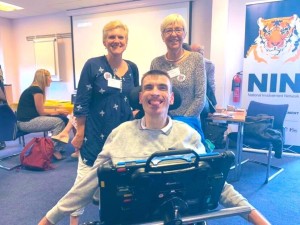
Last week, Laura Holmes, our NW England Associate, had the pleasure of interviewing our inspirational Founder, Joan Murphy. Joan will be retiring after our Talking Mats 21 event on 15th August 2019 and so this was a great opportunity to find out more about her Talking Mats experiences:
Are there any stand-out moments for you, from your Talking Mats time?
Talking Mats are now used in many countries across the world and it has been great to have the chance to travel widely. One particular moment which stands out for me was during one of two trips I made to China with Sally Boa. I was asked to demonstrate Talking Mats with a man who was in hospital having had a stroke. He had no speech and was using a wheelchair. I used Talking Mats to find out what the man felt he could/ couldn’t do. The man shared that he felt he could walk. I had to present the symbol three times as the family members and medical staff watching were adamant that the man could not walk. On the third time, the man pushed the table, moved his wheelchair back then stood up and walked around the room. His family and medical team were completely shocked and realised that no-one had actually thought to ask him if he could walk. This was a massive turning point both for the man – and also for his family and medical team, who could now see the power of using a Talking Mat.
Have you done any Talking Mats yourself that helped you to make an important decision for you or your family?
Absolutely – quite a few! My husband and I both used Talking Mats for our Power of Attorneys and shared them with our lawyer and grown-up children. My husband and I also used Talking Mats to talk about the Scottish Referendum as we had opposing views – it really helped as it made us listen to each other without interrupting. We then went on to use the mats as part of a presentation. Various members of my family have used mats to explore personal issues and decisions
What are the top tips you have gained from your Talking Mats journey – from working in the NHS and then more recently as a social enterprise?
You have to have humour. And be able to listen. It has been essential to be able to work in partnership with Lois and the other Talking Mats team members. The team are such nice people to work with and we have lots of laughs. Setting up as social enterprise was vital for Talking Mats – in terms of having the freedom to be creative. It felt as though someone had a big rubber band which was able to be released. It was a huge risk and there have been lots of leaps of faith along the way.
Do you have any top tips for people using Talking Mats in the Listener role?
Be quiet – and Listen! It’s also important to feel relaxed and to have a sense of humour whilst using it. A Talking Mat is not a test – it is serious, and can be used to explore difficult issues, but it should be fun.
Talking Mats is a low-tech AAC system – do you think it has a place in the modern world?
It is absolutely crucial! Low-tech resources are fundamental in terms of being able to have and develop conversation skills and social closeness.
What do you want for Talking Mats in the next 10 years?
World Domination! Talking Mats has the potential to be used everywhere in the world, by everyone. However I would like to see Talking Mats continue to have a small core team, but increasing Licensed Trainers across both the UK and the rest of the world.
Our Talking Mats is 21 Event is in Stirling on Thursday 15th August 2019. Thanks to funding from NHS Forth Valley endowment committee the event is free but you do need to book your space https://www.eventbrite.co.uk/e/talking-mats-is-21-tickets-62362171935
You can come to the morning only, afternoon only or come for the whole day.
If you can’t come to our event watch out for out blogs and social media celebrating the reach of Talking Mats for 21 days before the 15th of August. Please join in with your contributions using the hashtag #TMis21. For 21 days after our event we will be having a special Birthday offer! Watch this space, more to follow …….
 Online training login
Online training login 

